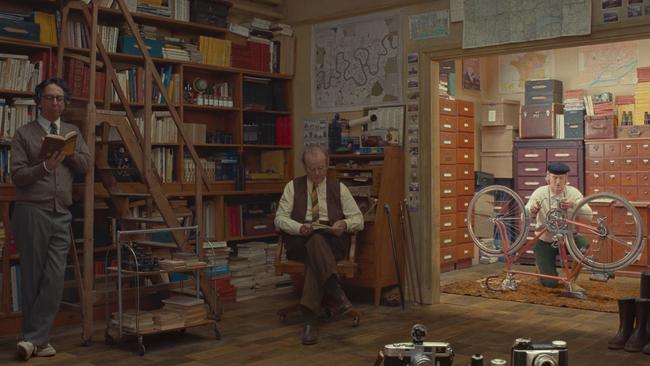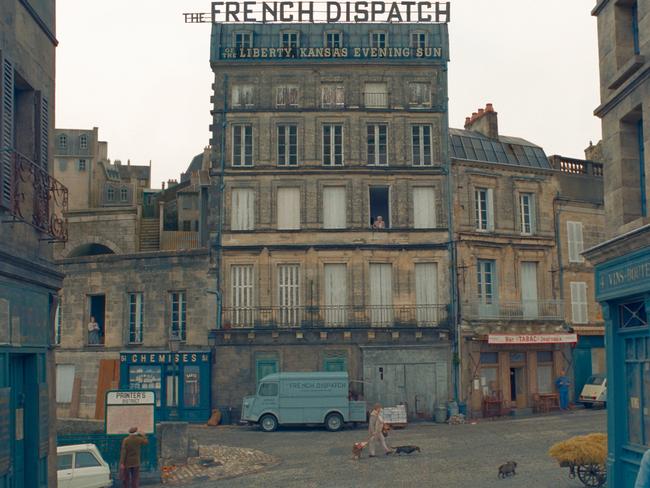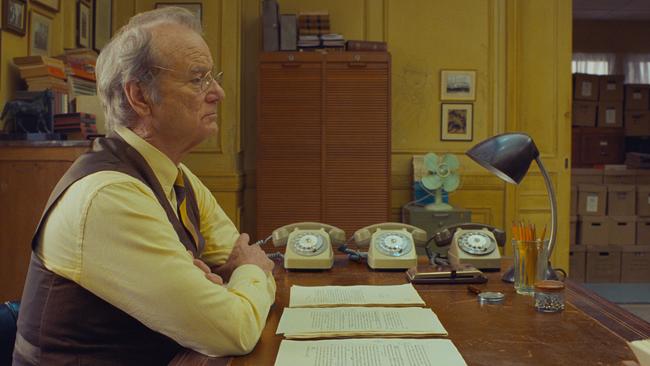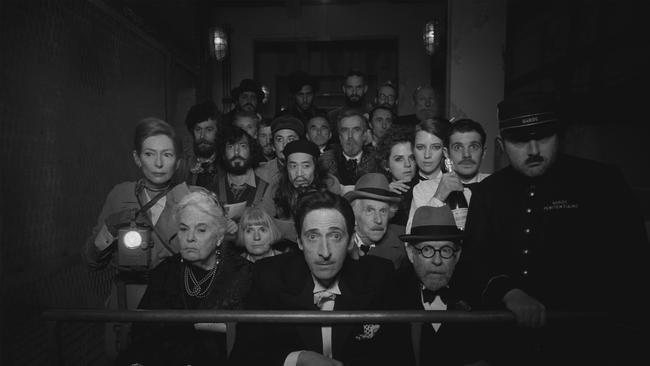Behind-the-scenes of Wes Anderson’s The French Dispatch
Wes Anderson’s The French Dispatch celebrates the tradition of long-form journalism with a cast of recurring actors synonymous with his films.

Wes Anderson’s latest film The French Dispatch was made in an abandoned felt factory outside of Angoulême, in the south west of France, which, if it wasn’t the absolute truth, would sound like the plot of a Wes Anderson movie.
But that’s actually what happened on The French Dispatch, the celebrated director’s ode to both France and the tradition of long-form journalism, loosely based on the archives of The New Yorker.
Anderson’s 10-film oeuvre, including The Royal Tenenbaums and The Grand Budapest Hotel, is characterised by meticulous and eclectic production design, a soothing colour palette, a recurring cast of actors – Tilda Swinton, Bill Murray and Frances McDormand to name a few – and an overall air of good-humoured eccentricity, all of which you’ll find in spades in The French Dispatch.
Looking to make his first movie in France, Anderson searched for somewhere cavernous, appealingly blank canvas-y, and – crucially – available, that he could transform into a working studio to make his biggest film yet. And here’s where the felt factory comes into the picture. It became the movie’s soundstage-meets- warehouse-meets-workshop-meets-atelier for the duration of filming, overseen by his longtime production designer Adam Stockhausen.
The pair first worked together on 2007’s The Darjeeling Limited; later, Stockhausen would design the titular Grand Budapest Hotel, a 19th-century jewel dripping in tasselled velvet and marble, and painted in a sweet candy pink.
“I feel like each time there’s a big idea that we have and it’s a bit of a gamble – we don’t know for sure that it’s going to work,” Stockhausen admits. That’s just what collaborating with the filmmaker is like.
“We are often figuring out a very intricate puzzle, making sure all the set pieces line up just right,” he explains. “Solving the puzzle is a huge challenge and very exciting each time.”
But on The French Dispatch, Anderson saddled the designer with his biggest task yet: a phenomenal 125 or so different sets, each microscopically detailed in its own way.
“It’s not that any of the sets were individually huge, but each one was very specific and had to be planned very exactly with the lens,” Stockhausen says. “It was a real challenge just to keep up.”
The French Dispatch is a lot of movie, jammed with characters spilling out over a series of vignettes, each of which is structured like a section of a magazine overseen by esteemed editor Arthur Howitzer Jr. (Murray) and staffed by a roster of writers, illustrators, copy editors and a few general runners-about.

Stockhausen designed their office from a reference image of a real newspaper in France: “A great yellow room with giant windows overlooking a street in Paris.” This is a movie seemingly engineered in a lab to please old media enthusiasts; in one scene, reporter Lucinda Krementz (McDormand) is commissioned to write 2,500 words about a student uprising and instead turns in 14,000 – with footnotes.
“It’s one of her best,” admits Arthur, leafing fondly through the pages, refusing to kill a single darling.
The film is full to bursting with Wes Anderson details: creaky old printing presses, curmudgeonly art collectors, tiny mustard-coloured espresso cups on tiny mustard-coloured saucers, scooters, radishes, typewriters, slide machines, a moustachioed Timothée Chalamet marinating in the bath, Owen Wilson riding a bicycle in a beret. But it also ripples with the pathos that Anderson always infuses into his work.

This is a movie about being a stranger in a strange land, far from home – even if that strange land is only France. Stockhausen envisioned the movie’s fictional setting, a French town amusingly called Ennui-sur-Blasé, as a location that is at once both charming and a little bit grimy. (Or, as Anderson’s frequent costume designer Milena Canonero puts it: “It’s not Avenue Montaigne French, it’s just French.”)
Stockhausen’s team hopped around Angoulême, spraying the buildings with water to darken them for the camera. “We were able to cheat a bit and make them feel older and dirtier,” he says, “but then, against that there are explosions of colour” – in particular great splashes of canary yellow.
The French Dispatch is stitched together from a mix of colour and black and white.
This combination presented a unique challenge for Canonero, a legendary multiple-Oscar winner, who has worked with Anderson four times as well as on Sofia Coppola’s Marie Antoinette. “You can’t shoot colour thinking you can just fade it to black and white,” she explains.

Some colours read darker – or lighter – in greyscale: red, for example, looks like brown, and if Canonero needed a white shirt, she actually had to find one in the palest blue.
In the black-and-white segments, Canonero chose a plaid kilt and leather jacket for teenage activist Juliette (Lyna Khoudri) and a stern double-breasted skirt suit for Simone, an artist’s muse played by Léa Seydoux. But in that rich, Andersonian colour, so deep you could swim in it, Canonero’s costumes come alive.
For McDormand’s no-nonsense correspondent, Canonero designed a two-piece in stewed-cherry red wool. “I was hoping to convey the warmth, intelligence and class of her character,” Canonero says. “So for inspiration, what else could there be but a Chanel suit?”
And for Swinton, who plays discerning critic J. K. L Berensen – a writer who expenses a month-long stay at a resort, all in the name of research – Canonero opted for a tangerine-hued silk gown, inspired in part by Swinton’s flaming wig. As the first costume worn during production “it was very important to get it right”, Canonero explains.
Canonero and her team crafted all of the core looks from scratch in their former-felt-factory atelier and she hand-picked outfits for more than a thousand extras. “Wes and I are very particular about the characters in the background,” Canonero stresses. “Every detail is important – the face, the physique and the clothes. Usually I do this alone in other movies, with Wes, I do it with him.”
Cinematographer Robert Yeoman first met Anderson in 1996, when he received a handwritten letter – “which I still have”, Yeoman shares – from the filmmaker, asking him whether he might be interested in a project.
Anderson was preparing to make his debut feature Bottle Rocket, starring his college roommate Owen Wilson. He was 27.
“He was very bright and had a clear vision for his film,” Yeoman recalls. “I immediately accepted. I obviously had no idea that that would be the first step to the many adventures that we have had since.”

Adventures that include Yeoman serving as cinematographer on every live-action film that Anderson has made, from Rushmore through to Moonrise Kingdom, all the way to The Grand Budapest Hotel – for which he was Oscar-nominated in 2015 – and The French Dispatch.
Yeoman is currently in Spain, with Stockhausen and Canonero, working on Anderson’s next film, an untitled, ultra-top-secret Western, teeming with stars including Margot Robbie, Scarlett Johansson and Tom Hanks.
“We are in Spain with an amazing cast and crew,” Yeoman shares. “Other than that, I can’t say much or Wes would be mad at me!”
Yeoman is one of Anderson’s closest collaborators. He is “a director who knows exactly what he wants”, the cinematographer says, which is both “refreshing” and creatively stimulating for his tight-knit team: “All of us in front and behind the camera bring our talents to help him create his world.”
Yeoman is responsible for getting the footage synonymous with Anderson’s aesthetic, like the languid tracking shots passing through minutely designed sets. (There was a particularly difficult one in The French Dispatch featuring actor Jeffrey Wright walking through a cacophonous police station.) And then there are those signature Anderson whip pans – when the camera shifts quickly but smoothly from one subject to another – which “are often nerve-racking for myself and the grips”, he admits. But mostly, Yeoman says that the secret is all in the lighting: “The sets are so carefully designed that you want to see them.”
He has never said no to an Anderson project, and neither has Canonero. “It’s always a yes with Wes,” she says. “I really look forward to it every time he calls me. It’s like going back to a family.” Adds Yeoman: “On every movie with Wes we are embarking on a lifetime adventure,” from filming on a boat anchored off the coast of Naples for The Life Aquatic with Steve Zissou to hoisting the camera on a real, moving train as it hurtled through Rajasthan on The Darjeeling Express.
“By living and working in other countries, my perception of the world has changed considerably,” Yeoman reflects.
That includes on The French Dispatch, where Anderson, his crew and some of the world’s biggest movie stars holed up in a boutique hotel for the duration of production.
Every night, Anderson and Yeoman – along with the occasional actor – would watch the day’s footage before retiring to dinner, where cast and crew were invited to eat together. It is this convivial spirit that has bonded his team.
“It can sometimes be a little intimidating sitting at a table with such a collection of movie stars,” Yeoman says, “but in all honesty, everyone is very nice and I have never seen the slightest hint of any type of ego clashes.”
Dinner with Murray, McDormand and Swinton crowded around a communal table, sharing war stories and production notes and a perfect main course? If it wasn’t the absolute truth, it would sound like the plot of a Wes Anderson movie.
The French Dispatch is in cinemas on December 9.
This article appears in the December issue of Vogue Australia, on sale November 29.


To join the conversation, please log in. Don't have an account? Register
Join the conversation, you are commenting as Logout